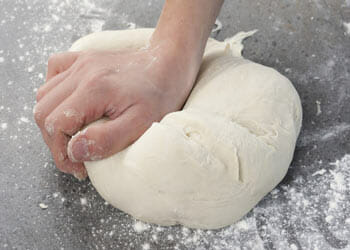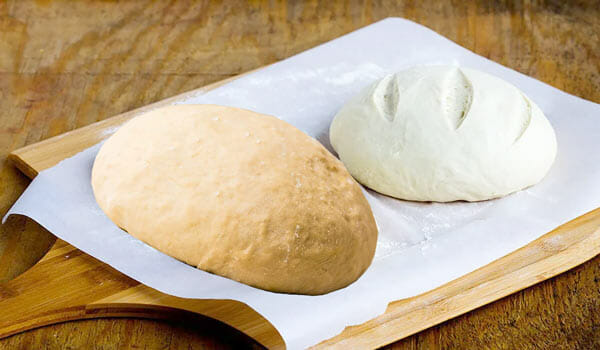Who doesn't like pizza? Well, the majority will say they love pizza. Do they know how to make it with perfection? If you are amongst the curious ones, willing to cook some scrumptious slices for your family and friends, then you must know how to deal with the most important aspect, the ‘dough’.
A common misinterpretation is that bread dough and pizza dough are the same. In reality, they are quite similar, and both fall into the category of leaven dough, a mixture that rises when baked as it contains baking soda and yeast. Now the question is what is the difference between pizza dough and bread dough?
To simplify things, we came up with this write-up to let you know the variability between these doughs.
What Is Pizza Dough?

The answer is simple, it is a mixture of ingredients kneaded to form a dough, later flattened to give you the pizza base. Pizza dough is made with basic ingredients like flour, water, baking soda, salt, yeast, and edible oils.
Some pizza makers use cornmeal to dust the pan where the pizza dough is going to be stretched. Cornmeal gives a flavorful crust and a bit of crispiness to it. When you order a pizza, you are likely to find cornmeal on the bottom of the crust. Adding a single tablespoon of sugar can make the dough tender if mixed with olive oil.
Advantages of Pizza Dough
The making of pizza dough requires you to add oil, which makes it easier for you to handle it, stretch it, thin it and even flat it out with ease.
Pizza dough can be baked faster when put in an oven. It takes less time than bread making.
Pizza mix can be used to make some other baked dishes like cinnamon rolls, monkey bread, turkey pot pies, Calzones, and other savory goods. A little addition so some ingredients might be needed such as oil and spices.
To make pizza dough, you won’t have to stress your hand for a long time due to kneading. It doesn’t require much kneading time.
Freezing pizza dough curbs down the fermentation and proofing process. The reaction becomes much slower. Therefore, the dough can last for a longer period without deteriorating.
Disadvantages Of Pizza Dough
Doesn’t use much water, so the moisture and fluff won’t be there. Not everyone likes a thick fluffy crust. But if like one, the standard dough will not be able to rise the crust.
You cannot make bread with the pizza dough, but bread dough can be flattened out to make pizza in time of need.
Cold dough must be brought back to room temperature and cannot be used right out of the fridge, which can be time-consuming.
The dearth of gluten in pizza dough usually results in a rigid mixture, which can be hard to stretch and has the chance to tear up. If not kneaded to an optimum level, it will keep going back to its original shape and not spread easily due to lack of gluten.
What Is Bread Dough?

Bread dough is a mixture of flour and other ingredients, which is later kneaded or rolled into a bread form.
Bread dough is comparatively firmer than pizza dough. It is about the perfect proofing and fermentation process when we talk about bread mixture. Fermentation process using yeast releases alcohol and other reactions, which give the bread a characterized aroma.
Proofing allows the dough mix to get a final rise. This is the specialty of bread doughs. To make basic bread dough, you need fundamental ingredients like flour, oil and water. Further, you can add milk, butter and eggs to bring out flavors and textures.
Advantages of Bread Dough
A positive thing about bread dough is that it has versatility. You can add some extra bits and make it work differently. For example add milk, butter, oil, sugar, or eggs to make sweetbreads for morning routine and milk bread alike.
This type of dough can be used to make pita bread, garlic knots, sweet milk breakfast rolls, pretzels, hot pockets, stuffed pizza, and many other delicious foods.
Bread dough has a lower gluten level. So people intolerant to gluten are safe to enjoy the final product. Although there is some gluten, but not as much as pizza dough.
Bread dough, when added with edible oil, can be made softer and therefore stretch out to make pizzas. In a desperate situation, you can always make a bread dough turn into a pizza dough.
Homemade bread dough doesn’t have preservatives and gives you the upper hand to tweak the taste and ingredients as you like. It tastes better right out of the oven, and therefore you stay satisfied if all goes right.
Disadvantages of Bread Dough
Mixing and kneading ingredients on a bread dough is an intricate process. It takes a lot of time and effort to bring out perfection.
It takes a longer time to bake. Bread dough must go through constant low temperature to be well done. Popping the temperature too high might burn out the bread.
Keeping bread dough consistent in taste can be a challenge for many. It takes precision from the baker’s hand to make flawless loaves over and over again.
Bread dough needs constant lookout, whether it’s rising properly or not. If the fluff is not doing well, then you are doing something wrong.
Freezing bread dough curbs the functionality of the yeast and therefore tends to deteriorate in terms of texture and strength.
Pizza Dough vs Bread Dough - Head to Head Comparison

Pizza is a form of bread and has many common characteristics to bread dough. Pizza can be rolled to thin crust, thicker ones, and more bready texture.
Now, bread dough and pizza dough are made with focal ingredients like flour, oil and water. However, there are many other criteria that distinguish one from the other. We are here to talk about them.
Ingredients
Flour, water, yeast, and baking soda are amongst the raw ingredients that go into making both pizzas and bread. Needless to say, you are making two different recipes and forms, so there will be something more to them.
Pizza doughs need oils to make them sticky, have stretchy moisture for a flat outcome and have a crunch to the base. While making bread dough, people sometimes add extra eggs, milk, sugar, and butter depending on the softness and flavors they seek. These subtle changes play a key role in the final result.
Moisture Level
In a pizza dough, the water level is much lower compared to the flour ratio. But the water is there, and oil is added to compensate for the lack of hydration. Pizza dough has about 50% of moisture in them.
Bread is softer and has a distinctive fluffiness to it. The water level is very high compared to the flour ratio. This gives the bread a unique characteristic and softness. Adding more water makes it easy to mix, and the fluidity is what allows the bread to rise during the baking period.
Most people avoid oil in bread dough, and some use it for textures. About 90% of the moisture is locked in bread dough.
Developing Gluten
Gluten helps to stretch a flour blend. You certainly need it while making delicious pizza. The mixing and kneading procedure in pizza making develops more gluten, and thus it is stretchable. This allows you to use your hand to flatten it out and stretch to give a thinner crust.
Whereas you don't need any excessive gluten formation for bread. You are not stretching it out anyway. A huge chunk of dough goes to the oven and comes out with the perfect loaves after baking.
Mixing Process
Mixing style and time maintenance are key to attaining the staple bread or pizza dough. You cannot continue to mix the ingredients for pizza dough for too long. It will make a dense mix and will not be soft enough to roll or stretch. The more you mix, the less chewy it becomes.
Bread mixture, on the other hand, needs to be mixed with perfection. To ensure the fluff and desired bread shapes, it's better to give it a whirl for a longer time.
Kneading Time
While making pizza, it's advised not to knead for too long. Pizza bottoms are chewy and stretchy, so just 5 minutes of decent squeezing and moulding should give you a smooth chunk of ball-shaped dough.
The more you knead bread dough, the less gluten it forms, thus less stretch. This is what you should aim for. Kneading for a longer period is a must to make the bread have correct inner density and firm outer body with adequate softness for tearing and slicing.
Time of Baking
The big variance between both dough is that there are variations in baking time and the heating process. Simplistically, pizzas are baked for a longer time compared to bread.
Pizza can be done within 8 to 10 minutes in an electric oven, whereas bread will surpass the time frame to rise and bring out the fluffs. Key point is that bread needs to be baked at a lower constant temperature for even distribution of heat.
Pizza Dough and Bread Dough: Are They Interchangeable?
It's a big no if you are looking for precision and perfection in your baking goods. But in case of distress, such as you have bread dough and want to make pizza in an emergency, you can go about it by trying to stretch the dough into the pizza base.
It will work during the time of need but will not be exemplary. It's advised not to interchange the dough if you are a perfectionist.
Take a look at the reference to know about some delicious foods you can make with these different doughs.
Final Thoughts
At first glance, you are likely to believe that bread dough and pizza dough are identical. But if you have gone through the bread dough vs. pizza dough we mentioned above, you should know the key characteristics that separate them from one another.
Although you can make some altering dishes, it is clear that both doughs are made specifically for different baking items, so don't try to swap one item with the other. Keep the differences in mind, and next time you go on to make pizza or bread, we hope you will be doing a stellar job.
SeaRanchLodge.com is a participant in the Amazon Associate program and will earn from qualifying purchases.


